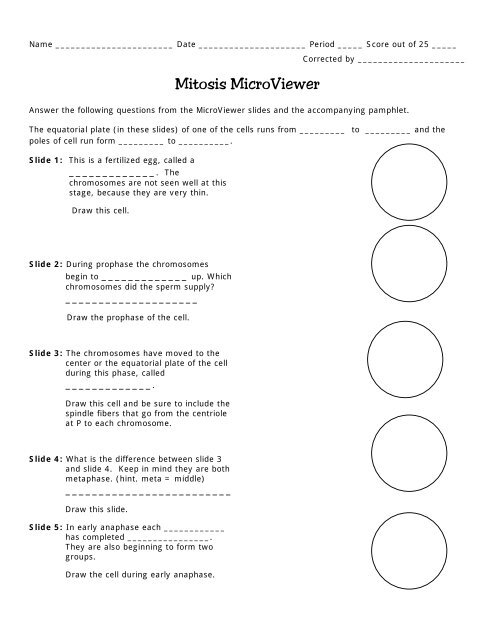Mitosis MicroViewer
Mitosis MicroViewer
Mitosis MicroViewer
- No tags were found...
You also want an ePaper? Increase the reach of your titles
YUMPU automatically turns print PDFs into web optimized ePapers that Google loves.
Name _______________________ Date _____________________ Period _____ Score out of 25 _____<br />
Corrected by _____________________<br />
<strong>Mitosis</strong> <strong>MicroViewer</strong><br />
Answer the following questions from the <strong>MicroViewer</strong> slides and the accompanying pamphlet.<br />
The equatorial plate (in these slides) of one of the cells runs from _________ to _________ and the<br />
poles of cell run form _________ to __________.<br />
Slide 1: This is a fertilized egg, called a<br />
_____________. The<br />
chromosomes are not seen well at this<br />
stage, because they are very thin.<br />
Draw this cell.<br />
Slide 2: During prophase the chromosomes<br />
begin to _____________ up. Which<br />
chromosomes did the sperm supply<br />
____________________<br />
Draw the prophase of the cell.<br />
Slide 3: The chromosomes have moved to the<br />
center or the equatorial plate of the cell<br />
during this phase, called<br />
_____________.<br />
Draw this cell and be sure to include the<br />
spindle fibers that go from the centriole<br />
at P to each chromosome.<br />
Slide 4: What is the difference between slide 3<br />
and slide 4. Keep in mind they are both<br />
metaphase. (hint. meta = middle)<br />
_________________________<br />
Draw this slide.<br />
Slide 5: In early anaphase each ____________<br />
has completed ________________.<br />
They are also beginning to form two<br />
groups.<br />
Draw the cell during early anaphase.
Slide 6: The eight chromosomes are now<br />
separated into _____________ groups<br />
and each group has _____________<br />
chromosomes<br />
Draw the late anaphase of the cell.<br />
Slide 7: In telophase the chromosomes have<br />
drawn completely apart and the cell is<br />
beginning to _____________.<br />
Draw telophase of the cell.<br />
Slide 8: In late _____________ the original<br />
_____________ has divided to form two<br />
daughter cells. Soon the whole process<br />
will start over.<br />
Draw the late telophase of the cell.<br />
You have been looking at cells from an ascaris. Here is some<br />
information about the ascaris:<br />
Ascariasis is a human disease caused by the<br />
parasitic roundworm Ascaris lumbricoides.<br />
Perhaps as many as one quarter of the world's<br />
people are infected, and ascariasis is particularly<br />
prevalent in tropical regions and in areas of poor<br />
hygiene.<br />
Infection occurs through ingestion of food<br />
contaminated with feces containing Ascaris<br />
eggs. The larvae hatch, burrow through the<br />
intestine, reach the lungs, and finally migrate up<br />
the respiratory tract. From there they are then<br />
reswallowed and mature in the intestine,<br />
growing up to 30 cm (12 in.) in length and<br />
anchoring themselves to the intestinal wall.<br />
Infections are usually asymptomatic (without<br />
obvious symptoms), especially if the number of<br />
worms is small. They may however be<br />
accompanied by inflammation, fever, and<br />
diarrhea, and serious problems may develop if<br />
the worms migrate to other parts of the body.<br />
~Wikipedia<br />
Ascaris nematodes have _________ chromosomes compared to<br />
humans which have ________ chromosomes.
















